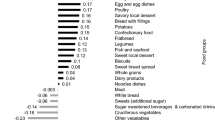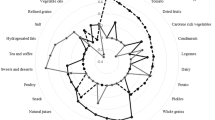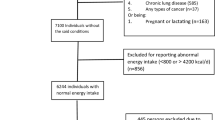Abstract
Background/Objectives:
We aimed to identify dietary patterns associated with inflammatory markers and to examine their impact on the incidence of coronary heart disease (CHD) and all-cause mortality, as subclinical inflammation is a risk factor for these outcomes.
Subjects/Methods:
The study population comprised 981 middle-aged men participating in the first or third ‘MONItoring of Trends and Determinants in CArdiovascular Diseases’ (MONICA) Augsburg surveys who completed 7-day dietary records. Subjects were followed up until 2002 for CHD and until 2007 for mortality. Dietary patterns were derived using reduced rank regression (RRR) with C-reactive protein, interleukin (IL)-6 and IL-18 as responses. Alternatively, partial least squares and principal components regression were used.
Results:
A high score of the RRR-derived pattern was characterised by high intakes of meat, soft drinks and beer and low intakes of vegetables, fresh fruit, chocolates, cake, pastries, wholemeal bread, cereals, muesli, curd, condensed milk, cream, butter, nuts, sweet bread spread and tea. This score was associated with a higher risk for CHD (hazard ratio=1.33, 95% confidence interval: 1.06–1.67, P=0.013) and mortality (hazard ratio=1.34, 1.17–1.53, P<0.001) after multivariable adjustment. However, for CHD and CHD mortality the significant association disappeared after further adjustment for smoking status; for all-cause mortality it was attenuated but remained significant (hazard ratio=1.16, 1.00–1.33, P=0.046). Patterns derived from the other methods resembled the RRR pattern showing similar results regarding disease outcomes.
Conclusions:
Participants exhibiting higher dietary pattern scores had higher levels of inflammatory markers and higher risk for CHD and all-cause mortality, however, smoking was an important confounder, especially for CHD outcomes.
This is a preview of subscription content, access via your institution
Access options
Subscribe to this journal
Receive 12 print issues and online access
$259.00 per year
only $21.58 per issue
Buy this article
- Purchase on Springer Link
- Instant access to full article PDF
Prices may be subject to local taxes which are calculated during checkout
Similar content being viewed by others
References
Bamia C, Trichopoulos D, Ferrari P, Overvad K, Bjerregaard L, Tjonneland A et al. (2007). Dietary patterns and survival of older Europeans: the EPIC-Elderly Study (European Prospective Investigation into Cancer and Nutrition). Public Health Nutr 10, 590–598.
Blankenberg S, Luc G, Ducimetiere P, Arveiler D, Ferrieres J, Amouyel P et al. (2003). Interleukin-18 and the risk of coronary heart disease in European men: the Prospective Epidemiological Study of Myocardial Infarction (PRIME). Circulation 108, 2453–2459.
Boniface DR, Tefft ME (2002). Dietary fats and 16-year coronary heart disease mortality in a cohort of men and women in Great Britain. Eur J Clin Nutr 56, 786–792.
Brunner EJ, Mosdol A, Witte DR, Martikainen P, Stafford M, Shipley MJ et al. (2008). Dietary patterns and 15-y risks of major coronary events, diabetes, and mortality. Am J Clin Nutr 87, 1414–1421.
Casas-Agustench P, Bullo M, Salas-Salvado J (2010). Nuts, inflammation and insulin resistance. Asia Pac J Clin Nutr 19, 124–130.
Fung TT, Willett WC, Stampfer MJ, Manson JE, Hu FB (2001). Dietary patterns and the risk of coronary heart disease in women. Arch Intern Med 161, 1857–1862.
He K, Song Y, Daviglus ML, Liu K, Van Horn L, Dyer AR et al. (2004). Accumulated evidence on fish consumption and coronary heart disease mortality: a meta-analysis of cohort studies. Circulation 109, 2705–2711.
Heidema AG, Thissen U, Boer JM, Bouwman FG, Feskens EJ, Mariman EC (2009). The association of 83 plasma proteins with CHD mortality, BMI, HDL-, and total-cholesterol in men: applying multivariate statistics to identify proteins with prognostic value and biological relevance. J Proteome Res 8, 2640–2649.
Heidemann C, Schulze MB, Franco OH, van Dam RM, Mantzoros CS, Hu FB (2008). Dietary patterns and risk of mortality from cardiovascular disease, cancer, and all causes in a prospective cohort of women. Circulation 118, 230–237.
Hense HW, Filipiak B, Döring A, Stieber J, Liese A, Keil U (1998). Ten-year trends of cardiovascular risk factors in the MONICA Augsburg Region in Southern Germany: results from the 1984/85, 1989/90 and 1994/1995 surveys. CVD Prevention 1, 318–327.
Herder C, Peltonen M, Koenig W, Sutfels K, Lindstrom J, Martin S et al. (2009). Anti-inflammatory effect of lifestyle changes in the Finnish Diabetes Prevention Study. Diabetologia 52, 433–442.
Heroux M, Janssen I, Lam M, Lee DC, Hebert JR, Sui X et al. (2010). Dietary patterns and the risk of mortality: impact of cardiorespiratory fitness. Int J Epidemiol 39, 197–209.
Hoffmann K, Boeing H, Boffetta P, Nagel G, Orfanos P, Ferrari P et al. (2005). Comparison of two statistical approaches to predict all-cause mortality by dietary patterns in German elderly subjects. Br J Nutr 93, 709–716.
Hoffmann K, Schulze MB, Schienkiewitz A, Nothlings U, Boeing H (2004). Application of a new statistical method to derive dietary patterns in nutritional epidemiology. Am J Epidemiol 159, 935–944.
Holt EM, Steffen LM, Moran A, Basu S, Steinberger J, Ross JA et al. (2009). Fruit and vegetable consumption and its relation to markers of inflammation and oxidative stress in adolescents. J Am Diet Assoc 109, 414–421.
Hu FB, Rimm EB, Stampfer MJ, Ascherio A, Spiegelman D, Willett WC (2000). Prospective study of major dietary patterns and risk of coronary heart disease in men. Am J Clin Nutr 72, 912–921.
Jylha M, Paavilainen P, Lehtimaki T, Goebeler S, Karhunen PJ, Hervonen A et al. (2007). Interleukin-1 receptor antagonist, interleukin-6, and C-reactive protein as predictors of mortality in nonagenarians: the vitality 90+ study. J Gerontol A Biol Sci Med Sci 62, 1016–1021.
Kaptoge S, Di Angelantonio E, Lowe G, Pepys MB, Thompson SG, Collins R et al. (2010). C-reactive protein concentration and risk of coronary heart disease, stroke, and mortality: an individual participant meta-analysis. Lancet 375, 132–140.
Koenig W, Khuseyinova N, Baumert J, Thorand B, Loewel H, Chambless L et al. (2006). Increased concentrations of C-reactive protein and IL-6 but not IL-18 are independently associated with incident coronary events in middle-aged men and women: results from the MONICA/KORA Augsburg case-cohort study, 1984–2002. Arterioscler Thromb Vasc Biol 26, 2745–2751.
Lowel H, Doring A, Schneider A, Heier M, Thorand B, Meisinger C (2005). The MONICA Augsburg surveys--basis for prospective cohort studies. Gesundheitswesen 67 (Suppl 1), S13–S18.
Lutsey PL, Jacobs Jr DR, Kori S, Mayer-Davis E, Shea S, Steffen LM et al. (2007). Whole grain intake and its cross-sectional association with obesity, insulin resistance, inflammation, diabetes and subclinical CVD: The MESA Study. Br J Nutr 98, 397–405.
Ma Y, Hebert JR, Li W, Bertone-Johnson ER, Olendzki B, Pagoto SL et al. (2008). Association between dietary fiber and markers of systemic inflammation in the Women's Health Initiative Observational Study. Nutrition 24, 941–949.
McNaughton SA, Mishra GD, Brunner EJ (2009). Food patterns associated with blood lipids are predictive of coronary heart disease: the Whitehall II study. Br J Nutr 102, 619–624.
Meisinger C, Thorand B, Schneider A, Stieber J, Doring A, Lowel H (2002). Sex differences in risk factors for incident type 2 diabetes mellitus: the MONICA Augsburg cohort study. Arch Intern Med 162, 82–89.
Mitrou PN, Kipnis V, Thiebaut AC, Reedy J, Subar AF, Wirfalt E et al. (2007). Mediterranean dietary pattern and prediction of all-cause mortality in a US population: results from the NIH-AARP Diet and Health Study. Arch Intern Med 167, 2461–2468.
Oliveira A, Rodriguez-Artalejo F, Lopes C (2010). Alcohol intake and systemic markers of inflammation--shape of the association according to sex and body mass index. Alcohol Alcohol 45, 119–125.
Osler M, Heitmann BL, Gerdes LU, Jorgensen LM, Schroll M (2001). Dietary patterns and mortality in Danish men and women: a prospective observational study. Br J Nutr 85, 219–225.
Qi L, van Dam RM, Liu S, Franz M, Mantzoros C, Hu FB (2006). Whole-grain, bran, and cereal fiber intakes and markers of systemic inflammation in diabetic women. Diab Care 29, 207–211.
Rodondi N, Marques-Vidal P, Butler J, Sutton-Tyrrell K, Cornuz J, Satterfield S et al. (2010). Markers of atherosclerosis and inflammation for prediction of coronary heart disease in older adults. Am J Epidemiol 171, 540–549.
Salas-Salvado J, Casas-Agustench P, Murphy MM, Lopez-Uriarte P, Bullo M (2008). The effect of nuts on inflammation. Asia Pac J Clin Nutr 17 (Suppl 1), 333–336.
Schulze MB, Hoffmann K, Manson JE, Willett WC, Meigs JB, Weikert C et al. (2005). Dietary pattern, inflammation, and incidence of type 2 diabetes in women. Am J Clin Nutr 82, 675–684.
Stork S, Feelders RA, van den Beld AW, Steyerberg EW, Savelkoul HF, Lamberts SW et al. (2006). Prediction of mortality risk in the elderly. Am J Med 119, 519–525.
Thorand B, Kolb H, Baumert J, Koenig W, Chambless L, Meisinger C et al. (2005). Elevated levels of interleukin-18 predict the development of type 2 diabetes: results from the MONICA/KORA Augsburg Study, 1984-2002. Diabetes 54, 2932–2938.
Troseid M, Arnesen H, Hjerkinn EM, Seljeflot I (2009). Serum levels of interleukin-18 are reduced by diet and n-3 fatty acid intervention in elderly high-risk men. Metabolism 58, 1543–1549.
Tuomisto K, Jousilahti P, Sundvall J, Pajunen P, Salomaa V (2006). C-reactive protein, interleukin-6 and tumor necrosis factor alpha as predictors of incident coronary and cardiovascular events and total mortality. A population-based, prospective study. Thromb Haemost 95, 511–518.
Waijers PM, Ocke MC, van Rossum CT, Peeters PH, Bamia C, Chloptsios Y et al. (2006). Dietary patterns and survival in older Dutch women. Am J Clin Nutr 83, 1170–1176.
Wang JJ, Tung TH, Yin WH, Huang CM, Jen HL, Wei J et al. (2008). Effects of moderate alcohol consumption on inflammatory biomarkers. Acta Cardiol 63, 65–72.
Wang SF, Xu JC, Liang QX (2006). Levels of plasma interleukin-18 and interferon-gamma in patients with coronary heart disease. Zhongguo Wei Zhong Bing Ji Jiu Yi Xue 18, 237–239.
Wannamethee SG, Lowe GD, Rumley A, Bruckdorfer KR, Whincup PH (2006). Associations of vitamin C status, fruit and vegetable intakes, and markers of inflammation and hemostasis. Am J Clin Nutr 83, 567–574.
Wannamethee SG, Whincup PH, Thomas MC, Sattar N (2009). Associations between dietary fiber and inflammation, hepatic function, and risk of type 2 diabetes in older men: potential mechanisms for the benefits of fiber on diabetes risk. Diab Care 32, 1823–1825.
Weikert C, Hoffmann K, Dierkes J, Zyriax BC, Klipstein-Grobusch K, Schulze MB et al. (2005). A homocysteine metabolism-related dietary pattern and the risk of coronary heart disease in two independent German study populations. J Nutr 135, 1981–1988.
Welsh P, Woodward M, Rumley A, MacMahon S, Lowe GD (2010). Does interleukin-18 or tumour necrosis factor-alpha have an independent association with the risk of coronary heart disease? Results from a prospective study in New Zealand. Cytokine 50, 94–98.
Willett W, Stampfer MJ (1986). Total energy intake: implications for epidemiologic analyses. Am J Epidemiol 124, 17–27.
Winkler G, Doring A, Keil U (2000). Trends in dietary sources of nutrients among middle-aged men in southern Germany. Results of the MONICA Project Augsburg: dietary surveys 1984/1985 and 1994/1995. MONItoring trends and determinants in CArdiovascular disease. Appetite 34, 37–45.
Zatonski W, Campos H, Willett W (2008). Rapid declines in coronary heart disease mortality in Eastern Europe are associated with increased consumption of oils rich in alpha-linolenic acid. Eur J Epidemiol 23, 3–10.
Zhang XH, Woo J, Heller RF (2009). Increasing dietary fish intake has contributed to decreasing mortality from CHD among the older population in Hong Kong. Public Health Nutr 12, 1248–1253.
Acknowledgements
We thank all members of the Institute of Epidemiology at the Helmholtz-Zentrum München and the field staff in Augsburg involved in the planning and conduct of the MONICA/KORA Augsburg studies. Furthermore, we thank Gerlinde Trischler (University of Ulm) and Gabi Gornitzka, Ulrike Poschen, and Karin Röhrig (all from the German Diabetes Center, Düsseldorf) for technical assistance and Andrea Schneider for excellent data management. Finally, we express our appreciation to all study participants. The MONICA/KORA Augsburg cohort study was funded by the Helmholtz Zentrum München and supported by grants from the Federal Ministry of Education and Research, Berlin. This study was supported by research grants from the German Research Foundation, Bonn, (TH-784/2-1 and TH-784/2-2) and by additional funds provided by the University of Ulm, the German Diabetes Center, Düsseldorf, the Federal Ministry of Health, the Ministry of Innovation, Science, Research and Technology of the state North Rhine Westphalia.
Author information
Authors and Affiliations
Corresponding author
Ethics declarations
Competing interests
The authors declare no conflict of interest.
Additional information
Supplementary Information accompanies the paper on European Journal of Clinical Nutrition website
Supplementary information
Rights and permissions
About this article
Cite this article
Meyer, J., Döring, A., Herder, C. et al. Dietary patterns, subclinical inflammation, incident coronary heart disease and mortality in middle-aged men from the MONICA/KORA Augsburg cohort study. Eur J Clin Nutr 65, 800–807 (2011). https://doi.org/10.1038/ejcn.2011.37
Received:
Revised:
Accepted:
Published:
Issue Date:
DOI: https://doi.org/10.1038/ejcn.2011.37
Keywords
This article is cited by
-
Comparison of data-driven identified hypertension-protective dietary patterns among Chinese adults: based on a nationwide study
European Journal of Nutrition (2023)
-
Effect of a diet based on the dietary guidelines for americans on inflammation markers in women at risk for cardiometabolic disease: results of a randomized, controlled trial
BMC Nutrition (2022)
-
Impact of overall diet quality on association between alcohol consumption and risk of hypertension: evidence from two national surveys with multiple ethnics
European Journal of Clinical Nutrition (2021)
-
The association between predicted inflammatory status and colorectal adenoma
Scientific Reports (2020)
-
Dietary patterns associated with inflammatory biomarkers in a Northern German population
European Journal of Nutrition (2020)



